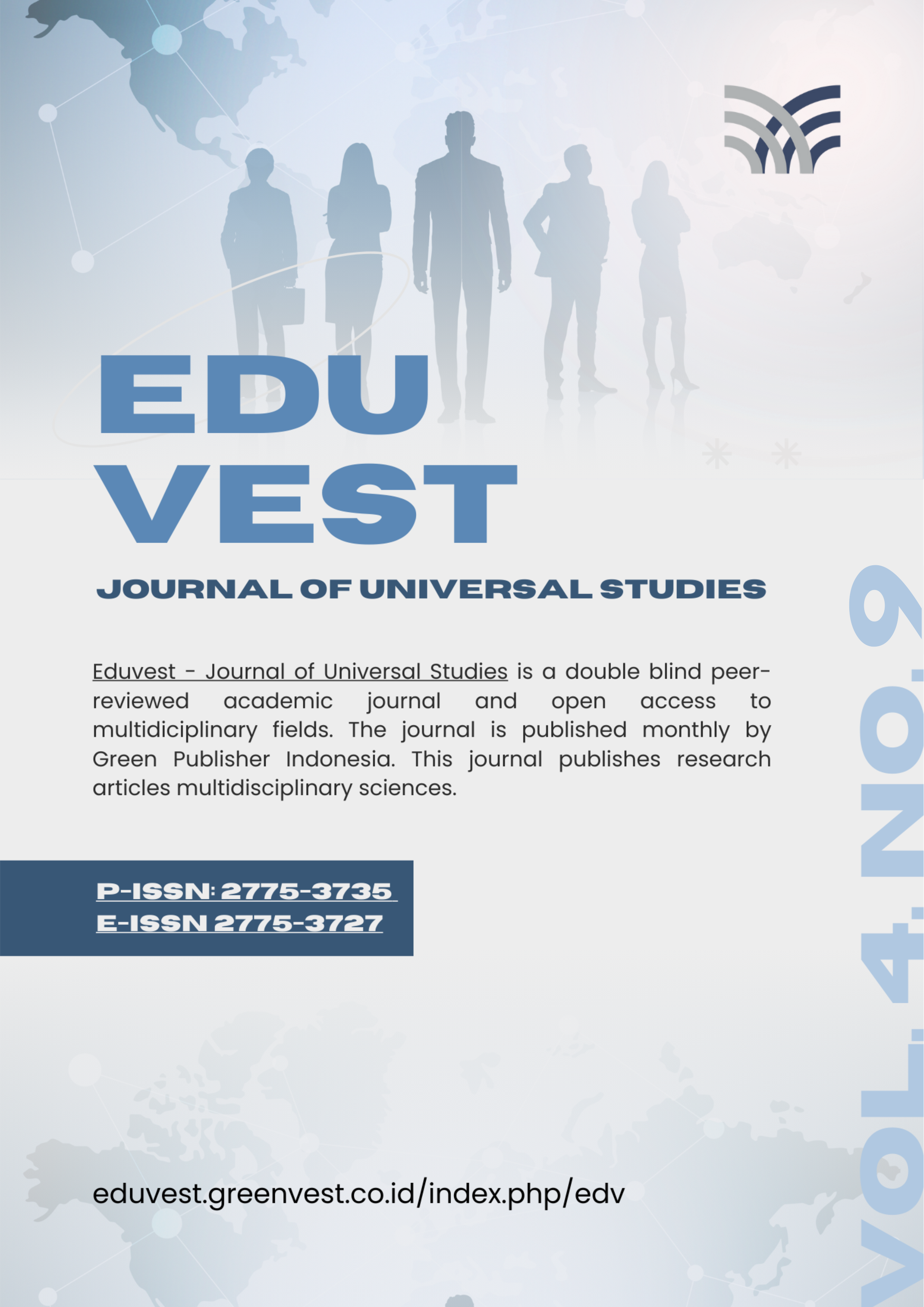The Influence of Alexithymia on the Tendency of Social Media Addiction in Early Adults in Karawang
DOI:
https://doi.org/10.59188/eduvest.v4i9.1779Keywords:
alexithymia, social media, early adults, emotion, addictedAbstract
The internet offers numerous features that simplify activities like communication, information retrieval, and transactions, making social media increasingly accessible. In Indonesia, individuals in their productive years, particularly early adulthood, dominate internet usage. This phase is characterized by repetitive behaviors, which can escalate the intensity of social media use and potentially lead to addiction. One factor influencing this tendency is alexithymia. This study aims to explore the impact of alexithymia on social media addiction tendencies among early adults in Karawang. Employing a quantitative causality design, the research utilized non-probability sampling, specifically snowball sampling, to gather data from 385 respondents aged 20-30 years residing in Karawang. The Toronto Alexithymia Scale (TAS) was used to measure alexithymia, while the Bergen Social Media Addiction Scale (BSMAS) assessed social media addiction tendencies. Reliability was tested using Cronbach's Alpha, with a threshold of > 0.08, while normality was evaluated through the Kolmogorov-Smirnov test at a 5% significance level. Linearity was assessed using an ANOVA test, yielding a significance of 0.468 > 0.05. The results of the simple linear regression test showed a significance value of 0.000 < 0.05, confirming the hypothesis that alexithymia significantly influences social media addiction tendencies in early adulthood in Karawang. The determination test results indicated that alexithymia accounts for 54.2% of the variance in social media addiction tendencies (R-Square = 0.542), with the remaining 45.8% attributed to other variables not examined in this study.
References
Az-Zahra, D. A. F., & Khairi, A. M. (2024). Exploring The Connection: Alexithymia Dan Kecanduan Media Sosial Pada Mahasiswa. Hudan Lin Naas: Jurnal Ilmu Sosial Dan Humaniora, 5(1), 73–88.
Azka, F., Firdaus, D. F., & Kurniadewi, E. (2018). Kecemasan Sosial Dan Ketergantungan Media Sosial Pada Mahasiswa. Psympathic: Jurnal Ilmiah Psikologi, 5(2), 201–210.
Azwar, S. (2016). Penyusunan Skala Psikologi Yogyakarta. Pustaka Pelajar.
Deonisius, R. F., Lestari, I., & Sarkadi, S. (2019). The Effect Of Digital Literacy To Internet Addiction. Jurnal Educatio: Jurnal Pendidikan Indonesia, 5(2), 71–75.
Dewi, N., & Trikusumaadi, S. K. (2016). Bahaya Kecanduan Internet Dan Kecemasan Komunikasi Terhadap Karakter Kerja Sama Pada Mahasiswa. Jurnal Psikologi, 43(3), 220–230.
Doni, F. R., & Faqih, H. (2017). Perilaku Penggunaan Media Sosial Pada Kalangan Remaja. Indonesian Journal On Software Engineering, 3(2), 15–23.
Fernandes, B., Maia, B. R., & Pontes, H. M. (2019). Internet Addiction Or Problematic Internet Use? Which Term Should Be Used? Psicologia Usp, 30, E190020.
Filibiana, N. D., & Wibowo, D. H. (N.D.). Fear Of Missing Out Dan Kecanduan Media Sosial Pada Remaja Awal. Proyeksi, 18(2), 157–165.
Geni, P. L. (2020). Struktur Internal Dan Validitas Konstruk Dari Toronto Alexithymia Scale (Tas-20) Dengan Sampel Mahasiswa Pada Universitas Di Jakarta. Jurnal Pengukuran Psikologi Dan Pendidikan Indonesia (Jp3i), 9(1), 30–40.
Griffiths, M. D., Kuss, D. J., & Demetrovics, Z. (2014). Social Networking Addiction: An Overview Of Preliminary Findings. Behavioral Addictions, 119–141.
Ihsani, I. N. M., Aiyuda, N., & Nasution, I. N. (2022). Pengalaman Afektif Sebagai Mediator Antara Penggunaan Media Sosial Terhadap Alexithymia Pada Mahasiswa Di Pekanbaru. Bandung Conference Series: Psychology Science, 2(3), 731–742.
Jamaludin, J., Syarifah, A., & Karyadi, K. (2022). Faktor-Faktor Penyebab Kecanduan Media Sosial Pada Mahasiswa Fakultas Ilmu Kesehatan Uin Syarif Hidayatullah Jakarta. Edu Dharma Journal: Jurnal Penelitian Dan Pengabdian Masyarakat, 6(2), 138–155.
Juwita, E. P., Budimansyah, D., & Nurbayani, S. (2015). Peran Media Sosial Terhadap Gaya Hidup Siswa. Sosietas: Jurnal Pendidikan Sosiologi, 5(1).
Khairunnisa, S., & Rusli, D. (2023). Hubungan Kecanduan Media Sosial Dengan Bedtime Procrastination Pada Remaja. Jurnal Pendidikan Tambusai, 7(1), 2143–2152.
Krisnadi, B., & Adhandayani, A. (2022). Kecanduan Media Sosial Pada Dewasa Awal: Apakah Dampak Dari Kesepian? Jca Of Psychology, 3(01).
Lestari, Y. M., Dewi, S. Y., & Chairani, A. (2020). Hubungan Alexithymia Dengan Kecanduan Media Sosial Pada Remaja Di Jakarta Selatan. Scripta Score Scientific Medical Journal, 1(2), 9.
Maheswari, J., & Dwiutami, L. (2013). Pola Perilaku Dewasa Muda Yang Kecenderungan Kecanduan Situs Jejaring Sosial. Jurnal Penelitian Dan Pengukuran Psikologi: Jppp, 2(1), 51–62.
Morin, C. R. W., & Rahardjo, W. (2021). Kecemasan Sosial, Kecenderungan Alexithymia Dan Adiksi Internet Pada Mahasiswa. Jurnal Psikologi, 14(1), 11–24.
Novita, S. A., Suprihatin, T., & Fitriani, A. (2021). Kecerdasan Emosional Dan Kecenderungan Alexithymia Pada Remaja Yang Tinggal Di Panti Asuhan. Psisula: Prosiding Berkala Psikologi, 3, 326–335.
Pangestuti, R., Adiningtyas, N., & Astuti, S. W. (2021). Level Alexithymia Pada Remaja Dan Intensitas Penggunaan Media Sosial. Jurnal Ilmiah Psikologi, 540–553.
Pradnyadewi, I., & Widiasavitri, P. N. (2023). Faktor-Faktor Penyebab Alexithymia Pada Remaja: Literature Review. Jurnal Psikologi Perseptual, 8(1), 60–79.
Purwaningsih, I. E., & Pratiwi, D. A. (2023). Alexithymia Tendencies In Adolescents Sidoharjo Gunungkidul. Jurnal Spirits, 14(1), 74–84.
Refnandes, R., Fajria, L., & Nelwati, N. (2022). Analisis Hubungan Kondisi Psikologis Dengan Kecanduan Gadget Pada Remaja Selama Masa Pandemi Covid 19 Di Kota Padang. Jurnal Ilmiah Universitas Batanghari Jambi, 22(2), 1318–1321.
Reynaldo, R., & Sokang, Y. A. (2016). Mahasiswa Dan Internet: Dua Sisi Mata Uang? Problematic Internet Use Pada Mahasiswa. Jurnal Psikologi, 43(2), 107–120.
Sri Mulyani, S. M. N. (2020). Hubungan Antara Kecenderungan Alexithymia Dengan Hubungan Dekat Pada Dewasa Awal. Jurnal Communicate, 6(1), 7–12.
Sugiyono. (2019). Metode Penelitian Kuantitatif Kualitatif Dan R&D. Alfabeta.
Udayanti, L. S. U. L. S., Muharis, I. A., Admiyanti, J. C., Pratama, M. R. I. Y., & Justin, L. (2023). Hubungan Kecanduan Penggunaan Media Sosial Dengan Gangguan Kualitas Tidur. Lombok Medical Journal, 2(2), 148–151.
Van Den Eijnden, R. J. J. M., Lemmens, J. S., & Valkenburg, P. M. (2016). The Social Media Disorder Scale. Computers In Human Behavior, 61, 478–487.
Wardani, R. K., Yosep, I., Yamin, A., & Mardhiyah, A. (2022). The Description Of Alexithymia In Nursing Students At Padjadjaran University With Social Media Addiction. Jurnal Keperawatan Komprehensif (Comprehensive Nursing Journal), 8(4).
Yulianti, T. E. (2022). Dampak Mengererikan Bullying Anak Di Zaman Media Sosial. Detikjabar. Https://Www.Detik.Com/Jabar/Berita/D-6190678/Dampak-Mengerikan-Bullying-Di-Zaman-Media-Sosial
Published
How to Cite
Issue
Section
License
Copyright (c) 2024 Alifiany Indah Suciaty, Wina Lova Riza, Dinda Aisha

This work is licensed under a Creative Commons Attribution-ShareAlike 4.0 International License.











